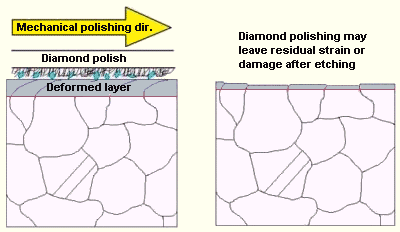
Alphabetical Index
Browse by Elements
Keyword Search
ASTM Electrolytes
Macro Etchants
Micro Etchants
Named Etchants
New Etchants
Al and Al Alloys
Cu and Cu Alloys
Fe and Fe Alloys
Ni and Ni Alloys
Carbide Etchants
Fluoride Etchants
Nitride Etchants
Other Etchants
Oxide Etchants
Phosphide Etchants
Single Crystal Etchants
Thin Film Etchants
Wafer Etchants
Help
Home
Final Polishing
For sample preparation, it is generally necessary to use an additional final polishing stage using colloidal silica. Final polishing should not be prolonged, but just sufficient to achieve the desired surface finish without causing excessive relief.

Note: Image by courtesy of Oxford Instruments.
Colloidal Silica is a chemo-mechanical polish, i.e., it combines the effect of mechanical polishing with etching. This type of stock removal is ideal in many cases, as a damage free surface can be obtained with little effort. Typical abrasive size is 0.05 micron. Note: Colloidal Silica crystallizes readily and will ruin polishing cloths if left to dry. Further, a film can form on the polished surface of the sample which must be removed. A convenient method to achieve this is to flush the polishing wheel with water during the last few seconds of polishing to clean the sample surface. Remove and dry the sample in the usual manner, using a solvent with low water content and not so volatile as to cause water condensation on the surface. Alcohol is ideal, whereas acetone is not. Flush the polishing wheel with water until all traces of colloidal silica is washed away, spin to drain and store in a suitable container such that contamination of the wheel cannot occur. Meticulous attention to avoiding contamination of wheels is an important aspect to achieve the best results.